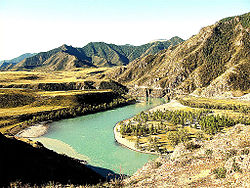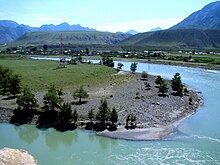Diluvium
Diluvium is an archaic term applied during the 1800s to widespread surficial deposits of sediments that could not be explained by the historic action of rivers and seas.Diluvium was defined as sediments, including boulder clays, laid down by geological processes that could no longer be observed."Diluvium" eventually became widely used in Europe, and was retained even into the 20th century for glacial deposits, long after the Noachian Flood explanation was quietly abandoned.[5] Buckland defined alluvium as surficial sediments laid down by processes currently active and observable, such as those associated with existing streams and coastal environments.[9][10] However, in 1888, Pavlov[11] coined the term deluvium, with an e, to designate products of weathered and altered rocks carried by slopewash and deposited on slopes and plains.


Katun RiverAltai RepublicNoachian FloodWilliam BucklandSussexboulder claysalluviumQuaternary PeriodAltai Mountainscatastrophic outburstsPleistoceneAltai floodsLake MissoulaNorth AmericaPavlovColluviumEluviumGiant current ripplesIlluviumGlaciersAufeisCirqueGlacieretIce capIce fieldIce sheetIce shelfIce streamLedoyomOutlet glacierPiedmont glacierRock glacierValley glacierAblation zoneAccumulation zoneBergschrundBlue iceCrevasseDirt coneGlacier caveGlacier headIce divideGlacier tongueIcefallLateral moraineMedial moraineMoraineMoulinPenitenteRandkluftSéracTerminusAblationAccumulationBasal slidingCalvingMotionOutburst floodOverdeepeningPeriglaciationPluckingRetreatStarvationIce coreMass balanceJökulhlaupSubglacial eruptionSubglacial volcanoLandformsArêteCirque stairwayCrag and tailFinger lakeGlacial hornGlacial lakeGlacial striaeHanging valleyNunatakP-formRibbon lakeRoche moutonnéeSuncupTrough lakeTrough valleyTunnel valleyValley stepZungenbeckenDrumlinErratic blockMoraine-dammed lakePulju moraineRogen moraineSevetti moraineTerminal moraineTill plainVeiki moraineGlaciofluvialAlpentorKame deltaKettle holeOutwash fanSandurUrstromtalGlaciers on MarsGlaciologyPost-glacial reboundGlacial lake outburst floodGlacial periodTimeline of glaciationQuaternary glaciationIllinoian StageInterglacialInterstadialPenultimate Glacial PeriodLast Glacial PeriodLast Glacial MaximumMousterian PluvialHolocene glacial retreatOldest DryasOlder DryasPre-Illinoian StageSangamonian StageWisconsin glaciationBølling–Allerød warmingLate Glacial InterstadialHuelmo–Mascardi Cold Reversal